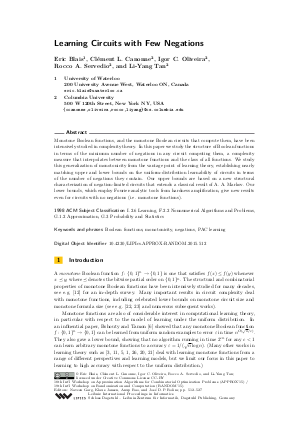Learning Circuits with few Negations
Authors Eric Blais, Clément L. Canonne, Igor C. Oliveira, Rocco A. Servedio, Li-Yang Tan
-
Part of:
Volume:
Approximation, Randomization, and Combinatorial Optimization. Algorithms and Techniques (APPROX/RANDOM 2015)
Part of: Series: Leibniz International Proceedings in Informatics (LIPIcs)
Part of: Conference: International Conference on Randomization and Computation (RANDOM)
Part of: Conference: International Conference on Approximation Algorithms for Combinatorial Optimization Problems (APPROX) - License:
 Creative Commons Attribution 3.0 Unported license
Creative Commons Attribution 3.0 Unported license
- Publication Date: 2015-08-13
File

PDF
LIPIcs.APPROX-RANDOM.2015.512.pdf
- Filesize: 0.53 MB
- 16 pages
Document Identifiers
Subject Classification
Keywords
- Boolean functions
- monotonicity
- negations
- PAC learning
Metrics
- Access Statistics
-
Total Accesses (updated on a weekly basis)
0PDF Downloads0Metadata Views
Abstract
Monotone Boolean functions, and the monotone Boolean circuits that compute them, have been intensively studied in complexity theory. In this paper we study the structure of Boolean functions in terms of the minimum number of negations in any circuit computing them, a complexity measure that interpolates between monotone functions and the class of all functions. We study this generalization of monotonicity from the vantage point of learning theory, establishing nearly matching upper and lower bounds on the uniform-distribution learnability of circuits in terms of the number of negations they contain. Our upper bounds are based on a new structural characterization of negation-limited circuits that extends a classical result of A.A. Markov. Our lower bounds, which employ Fourier-analytic tools from hardness amplification, give new results even for circuits with no negations (i.e. monotone functions).
Cite As Get BibTex
Eric Blais, Clément L. Canonne, Igor C. Oliveira, Rocco A. Servedio, and Li-Yang Tan. Learning Circuits with few Negations. In Approximation, Randomization, and Combinatorial Optimization. Algorithms and Techniques (APPROX/RANDOM 2015). Leibniz International Proceedings in Informatics (LIPIcs), Volume 40, pp. 512-527, Schloss Dagstuhl – Leibniz-Zentrum für Informatik (2015)
https://doi.org/10.4230/LIPIcs.APPROX-RANDOM.2015.512
BibTex
@InProceedings{blais_et_al:LIPIcs.APPROX-RANDOM.2015.512,
author = {Blais, Eric and Canonne, Cl\'{e}ment L. and Oliveira, Igor C. and Servedio, Rocco A. and Tan, Li-Yang},
title = {{Learning Circuits with few Negations}},
booktitle = {Approximation, Randomization, and Combinatorial Optimization. Algorithms and Techniques (APPROX/RANDOM 2015)},
pages = {512--527},
series = {Leibniz International Proceedings in Informatics (LIPIcs)},
ISBN = {978-3-939897-89-7},
ISSN = {1868-8969},
year = {2015},
volume = {40},
editor = {Garg, Naveen and Jansen, Klaus and Rao, Anup and Rolim, Jos\'{e} D. P.},
publisher = {Schloss Dagstuhl -- Leibniz-Zentrum f{\"u}r Informatik},
address = {Dagstuhl, Germany},
URL = {https://drops.dagstuhl.de/entities/document/10.4230/LIPIcs.APPROX-RANDOM.2015.512},
URN = {urn:nbn:de:0030-drops-53214},
doi = {10.4230/LIPIcs.APPROX-RANDOM.2015.512},
annote = {Keywords: Boolean functions, monotonicity, negations, PAC learning}
}
Author Details
References
-
K. Amano and A. Maruoka. On learning monotone Boolean functions under the uniform distribution. In International Conference on Algorithmic Learning Theory (ALT), pages 57-68, 2002.

-
K. Amano and A. Maruoka. A Superpolynomial Lower Bound for a Circuit Computing the Clique Function with At Most (1/6) log log n Negation Gates. SIAM Journal on Computing, 35(1):201-216, 2005.

-
D. Angluin. Queries and concept learning. Machine Learning, 2:319-342, 1988.

-
E. Blais and L-Y. Tan. Approximating Boolean functions with depth-2 circuits. In Conference on Computational Complexity (CCC), pages 74-85, 2013.

-
A. Blum, C. Burch, and J. Langford. On learning monotone Boolean functions. In Symposium on Foundations of Computer Science (FOCS), pages 408-415, 1998.

-
N. Bshouty and C. Tamon. On the Fourier spectrum of monotone functions. Journal of the ACM, 43(4):747-770, 1996.

-
V. Feldman, H. K. Lee, and R. A. Servedio. Lower bounds and hardness amplification for learning shallow monotone formulas. Journal of Machine Learning Research - Proceedings Track, 19:273-292, 2011.

-
O. Goldreich and R. Izsak. Monotone circuits: One-way functions versus pseudorandom generators. Theory of Computing, 8(1):231-238, 2012.

-
S. Guo and I. Komargodski. Negation-limited formulas. Technical Report 22(26), Electronic Colloquium on Computational Complexity (ECCC), 2015.

-
S. Guo, T. Malkin, I. C. Oliveira, and A. Rosen. The power of negations in cryptography. In Theory of Cryptography Conference (TCC), pages 36-65, 2015.

-
M. Kearns and L. Valiant. Cryptographic limitations on learning Boolean formulae and finite automata. Journal of the ACM, 41(1):67-95, 1994.

-
A. D. Korshunov. Monotone Boolean functions. Russian Mathematical Surveys (Uspekhi Matematicheskikh Nauk), 58(5):929-1001, 2003.

-
N. Linial, Y. Mansour, and N. Nisan. Constant depth circuits, Fourier transform and learnability. Journal of the ACM, 40(3):607-620, 1993.

-
A. A. Markov. On the inversion complexity of systems of functions. Doklady Akademii Nauk SSSR, 116:917-919, 1957. English translation in [Markov, 1958].

-
A. A. Markov. On the inversion complexity of a system of functions. Journal of the ACM, 5(4):331-334, October 1958.

-
H. Morizumi. Limiting negations in formulas. In International Colloquium on Automata, Languages, and Programming (ICALP), pages 701-712, 2009.

-
H. Morizumi. Limiting negations in non-deterministic circuits. Theoretical Computer Science, 410(38-40):3988-3994, 2009.

-
E. Mossel and R. O'Donnell. On the noise sensitivity of monotone functions. Random Structures and Algorithms, 23(3):333-350, 2003.

-
R. O'Donnell. Computational applications of noise sensitivity. PhD thesis, MIT, June 2003.

-
R. O'Donnell and R. Servedio. Learning monotone decision trees in polynomial time. SIAM Journal on Computing, 37(3):827-844, 2007.

-
R. O'Donnell and K. Wimmer. KKL, Kruskal-Katona, and monotone nets. SIAM Journal on Computing, 42(6):2375-2399, 2013.

-
Ran Raz and Avi Wigderson. Monotone circuits for matching require linear depth. Journal of the ACM, 39(3):736-744, 1992.

-
A. Razborov. Lower bounds on the monotone complexity of some Boolean functions. Doklady Akademii Nauk SSSR, 281:798-801, 1985. English translation in: Soviet Mathematics Doklady 31:354-357, 1985.

-
B. Rossman. Correlation bounds against monotone NC¹. In Conference on Computational Complexity (CCC), 2015.

-
M. Santha and C. Wilson. Limiting negations in constant depth circuits. SIAM Journal on Computing, 22(2):294-302, 1993.

-
R. Servedio. On learning monotone DNF under product distributions. Information and Computation, 193(1):57-74, 2004.

-
S. Sung and K. Tanaka. Limiting Negations in Bounded-Depth Circuits: an Extension of Markov’s Theorem. In International Symposium on Algorithms and Computation (ISAAC), pages 108-116, 2003.

-
M. Talagrand. How much are increasing sets positively correlated? Combinatorica, 16(2):243-258, 1996.

